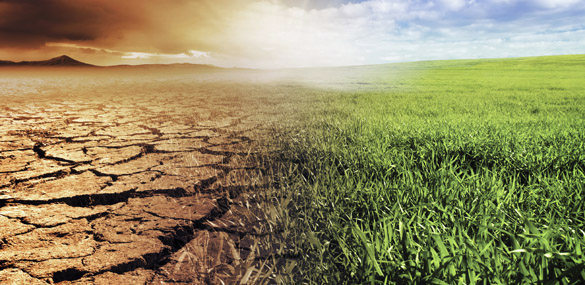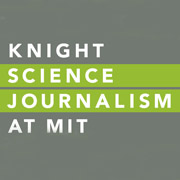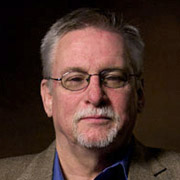ENVIRONMENT: CLIMATE CHANGE
Knight Science Journalism Bootcamp speakers cite communications as key to better climate change policies

"The future of our species depends on better policies for energy and climate change — and that progress requires good communications, and an informed public."
— Philip Hilts, Director, Knight Science Journalism at MIT, 2009-2104
“The climate change crisis is no longer primarily a scientific problem. At this stage, it is a communications issue.”
That assessment, from Scott Denning, Monfort Professor of Atmosphere Science at Colorado State University, was a frequent refrain during a recent MIT Knight Science Journalism “Bootcamp on Energy and Climate.” Many of the distinguished presenters at the intensive three-day course emphasized that scientists have established the evidence about climate change, and journalists now have a crucial role to educate the public about its impacts.
The twelve presenters also agreed that the stakes are high for their work. In his remarks, Philip Hilts, director of the KSJ program said: “The future of our species depends on better policies in energy and climate issues — and that progress requires an informed public.”
This point of view is also emphasized in "What We Know," the 2014 UN Intergovernmental Panel on Climate Change (IPCC) report, published not long after the KSJ Bootcamp. In a podcast, Nobel laureate Mario Molina, chair of the IPCC report, distills the findings to four points (climate change is taking place; it is happening already; it is about risk; we can deal with this), and notes that the primary purpose of the accessible report is to engage the public and professional communicators to help catalyze forward-looking climate change policy.
Educating journalists
The Energy and Climate Change Bootcamp is part of an ongoing series of short courses created by the KSJ program, which each year admits 13 exceptional, mid-career science journalists from around the world. The Fellows spend a full academic year at MIT honing their reporting skills, while working alongside scientists, and studying with humanities and social science scholars.
The only one of its kind in the world, the program has run for 31 years and created 320 alumni who are now continuing their science writing at major news outlets in 40 countries. Four times a year, the KSJ program offers the intensive bootcamps, which are attended not only by the Fellows, but also by other journalists who apply to participate.
“We believe that reporters need access to the best minds across science and technology to fulfill their mission,” says Hilts, “and we want to share MIT's resources with science journalists broadly. We know it is hard for many journalists to get away from major institutions for an entire year. However, many more can break away for a few days at a time, so we designed the short courses to reach more of the science journalism community.”
The Energy and Climate Bootcamp has been held each year for three years, reflecting the complexity of the topic and its increasing significance. The most recent speakers, who included leading scientists and spokespersons in the field, gave presentations that ranged from the current science about climate change, to the attitudes of the American public on the issue, and how climate change issues can be addressed in a difficult political climate.
Related Story
3 Questions with Paul Raeburn: How the KSJ Tracker raises the bar for science media
"Our goal is to provide an informal peer review of science reporting, which we hope will help improve science coverage across the board." Story
The basic science of climate change
Denning began his presentation by reviewing the fundamental science behind anthropogenic, or human-caused global warming. He explained that carbon dioxide and other greenhouse gases in the Earth’s atmosphere trap radiation, or heat, warming the Earth’s surface. In balanced proportions, greenhouse gases function similar to a blanket surrounding the Earth, by maintaining temperatures within a range that enables life to thrive.
As increasing amounts of carbon dioxide are emitted into the atmosphere — through the burning of fossil fuels for transportation and industrial purposes, as well as the generation of electricity — the blanket grows thicker and traps more heat, which leads to a considerably warmer planet.
Recognizing and observing the evidence
Despite the scientific evidence that substantiates climate change, it has been difficult for the public to appreciate its potential consequences, said Susan Solomon, the Ellen Swallow Richards Professor of Atmospheric Chemistry and Climate Science in the MIT Department of Chemistry, during her presentation.
In Solomon’s analysis, this gap between evidence and awareness occurs because very few traces of global warming are visible locally. Lacking immediate signs in their own territory, many people still do not perceive the enormity and impact of the climate change phenomenon.
Given this situation, Solomon observes, the climate change conversation has also digressed into a debate that is more about individual beliefs, rather than actual science. “This issue attracts all kinds of interesting discussions about people’s personal beliefs of what the world should or could look like,” she said. “The conversation has now morphed into a discussion about the world’s future — but without a basis in the scientific evidence, and how to solve this accelerating threat to our life on earth.”
Public perception
The wide-range of individual beliefs among the public on how and when to embark on addressing climate change is a primary obstacle to policy chance and action, according to Tom Zeller, Jr., a current KSJ Fellow. “For some folks, the problem remains a very distant one, and they discount the need to take immediate drastic or expensive actions. For others, this is a clear and present emergency with deep moral implications.”
Nevertheless, Zeller, Jr. believes that the increasing amount of research conducted about climate change, in addition to other factors are helping to alter the general public perception about climate change.
“It’s worth noting that most Americans do accept that the climate is changing and that human activity is a driver,” said Zeller. “And, as the science gets more specific on how grim things might ultimately get, that will help more people comprehend the seriousness of the issue. I also think some of the bizarre weather patterns we’ve been experiencing, regardless of whether or not they can be directly tied to anthropogenic global warming, are helping bring the issue to the forefront of public awareness.”
Reformulating the climate change message
During his presentation “Energy, Climate, and the American Public,” Stephen Ansolabehere, Professor of Government at Harvard University, offered a suggestion about language and emphasis. He noted that while most Americans are concerned about climate change, describing the issue as “global” climate change makes the problem seem faraway. And since most Americans are not primarily motivated by realities that seem remote, the usual phrase “global climate change” will not, by itself, be effective for building support for new energy policies.
Instead, Ansolabehere encourages policy makers, scientists, and journalists to show the importance of preventing and remedying local environmental damage caused by climate change. Most of us, he said, have a heightened concern for what is occurring in our own backyards, communities, and regions.


Note | Knight Science Journalism Program director Philip Hilts, to step down
As this story was being readied for publication, Phil Hilts, director of the Knight Science Journalism Program at MIT for the past six years, announced that he will retire as director at the end of June. He is beginning research for a book on new solar energy technology, and will continue at MIT as a research associate. Under Hilts' leadership the number of applications to the KSJ program and the number of boot camps both doubled. Hilts created training courses in video and audio storytelling; brought in coaches on the uses of social media; established data journalism training for the fellows; set up a new Project Fellowship; and established annual campus events. He also taught the basics of newswriting in MIT’s Graduate Program in Science Writing. A journalist since 1968, Hilts is the author of six books, and served as a prize-winning science writer at both The New York Times and The Washington Post. At the NYTs he broke the story of the tobacco industry’s 40-year cover up of its own research showing that tobacco was both harmful and addictive.
Full announcement at MIT News
Suggested Links
Knight Science Journalism Fellowships at MIT
Philip Hilts, KSJ website | Author website
3 Questions with Paul Raeburn | KSJ Tracker
KSJ Tracker | KSJ Media Gallery
Archive: Elevating the Discourse | Meet the KSJ Fellows
Archive: Communicating Climate Change
2014 Report | UN Intergovernmental Panel on Climate Change
Nobel Podcast | What we Know about Climate Change | Mario Molina
Story prepared by MIT SHASS Communications
Editor and Designer: Emily Hiestand
Published 10 April 2014